

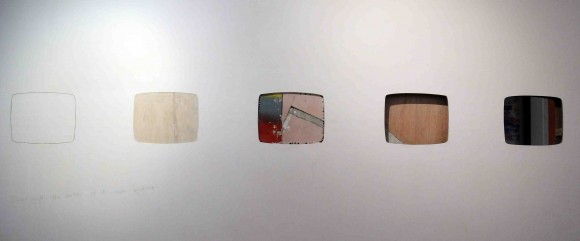
"Video with the Story of Its Own Making", 2009, Mixed Media, Variable Dimensions, Image Courtesy and photography by M.M. Yu
Manila, Philippines
Exhibition: Cold Cuts: Nilo Ilarde at Mag:net Gallery
There is so much going on in the region that our readers should know about. Since Arteri Eds have been travelling a lot in the past few months we wanted to bring to your attention some of the highlights from these trips. Whilst still supporting and covering Malaysian news and reviews, expect more regional posts and artist profiles over the next few weeks as we try to bring a slice of contemporary Southeast Asia to your computer screens. Please check out associated websites and blogs linked in these articles too because knowledge is power people. (Eds)
Tough love, that’s about all Manila can offer its embattled citizens and those brave tourists disorientated by the smells of lechon manok and Jeepney exhaust fumes. Together they follow the pink line over the 7 mini cities that make up the intoxicating capital of the Philippines. However, try to settle in, let the pollution develop a thin film over you, have some roasted meat, and drink a San Miguel which promotes Philippino friendship, as it says on the back of the bottle. Because, there is much to leave you breathless, but not from the smoke. The art scene there endures much of what other Southeast centres including Malaysia have to face, emasculated institutions, little to no government funding, small public audiences and commercial galleries dominated by painting that diminishes the support of non-sellable conceptual orientated work. But, the scene there seems to be much more of a supportive dialogue and there are pockets of alternative spaces who are committed to discourse and experimentation.

Detail from "Video with the Story of Its Own Making", Image Courtesy of M.M. Yu
On the last day of a recent trip to Manila, we went to see Nilo Ilarde’s exhibition Cold Cuts at gallery/cafe Mag:net 1 in Quezon City. Ilarde is a mid career conceptual artist and curator known for his artistic interventions of internal gallery architecture. Informed and referencing the principles espoused in Brian ODoherty’s 1976 ground breaking essays Inside the White Cube 2 and strategies by artists such as Gordon Matta Clark’s deconstructivist cutting and Donald Judd’s specific objects, his practice reveals the physical framework of the gallery as a site of play, deconstruction, dissemination and content. By stripping away paint and cutting into the walls to reveal the layers of its forgotten past, Ilarde’s exhibition is testament to how conceptualism and a small space, can pack the same knock out punch as Philippino national hero and boxer Manny Pacquio’s recent bout that ended in a spectacular second round defeat of Englishman Ricky Hatton.
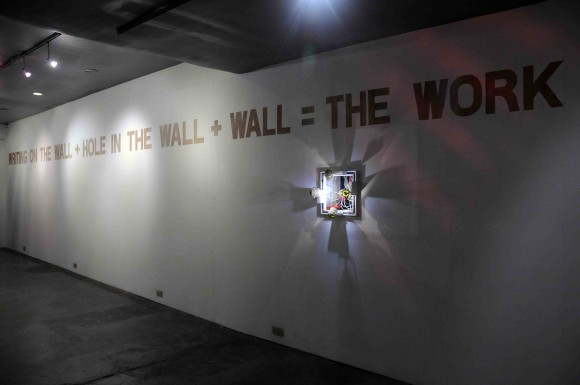
"Writing on the Wall + Hole in the The Wall + Wall = The Work", 2009, Mixed Media, Variable Dimensions, Image Courtesy of Mag:net Gallery, Photography by M.M. Yu
Ilarde’s exhibition uses the gallery as both site and medium to create his works. Context becomes content. With the resulting ‘objects’ framing the gallery as much as it frames them. The text piece on the gallery wall, created by stripping away areas of paint to create the lettering could not make its intent more obvious. Writing on the Wall + Hole in the Wall + Wall = The Work. With similar humour, wit and a confident grasp of excavation he conducts conversations with various media and art historical concepts. Painting, video art, light boxes and sculpture are ‘recreated’ through the wounding, extraction and revealing of the physical space of the gallery. By destabilising the wall, often regarded as an impenetrable, authoritarian surface for artwork, Ilarde constructs windows, into the belly of conceptualism and ponderings on different media. Video with the story of its own making, is a frame by frame reference to moving image in art. It starts with a simple drawn outline of a small video screen on the wall supporting the stairway connecting the gallery and the café on the floor above. It then gives way to 4 more ‘screens’ whose reductive sequence goes deeper into the layers of the gallery wall: layers of paint and plywood end in an outright hole that looks into the stairwell. Ilarde’s inverted light box Higher Powers Command: Let There Be Lightboxes, reveals the electrical entrails of the circuitry behind the wall and was a favourite with audiences, a behind the scenes voyeuristic look or ‘open heart surgery” of sorts. And his reference to Judd’s specific objects in Specific Abject where 4 square sections of the wall were removed to then be put together to create a box on the gallery floor that houses the construction remnants from the show is yet more enjoyable poetic dialogues by the artist. Another work of thousands of empty paint tubes collected from fellow artists imbedded in Ilarde’s roughtly created recession on the back wall, called I have Nothing to Paint and I Am Painting I was a mixture of sentiment and challenge, that referenced the act of painting as well as a nod to his fellow artists who donated them. This piece also seemed an observation on the restrictions of painting by its two dimensional surface that is often confined and limited by the wall. It was however, still the video work which I felt was the most compelling. The pace of the exhibition is slow, and by slow I mean considered, thoughtful, and rhythmic. I enjoyed how the allusion to the speed of moving image as seen in mindless televisions and fantastical and grandiose film was halted, and embedded into the gallery, a sort of burial and an unearthing of thinking around the genre and its relationship with conceptualism. You can poke your head through it to, literally piercing through the membrane of the gallery.

"Higher Powers Command: Let There Be Lightboxes", 2009, Mixed Media, Variable Dimensions, Image Courtesy of Mag:net Gallery, Photography by M.M. Yu
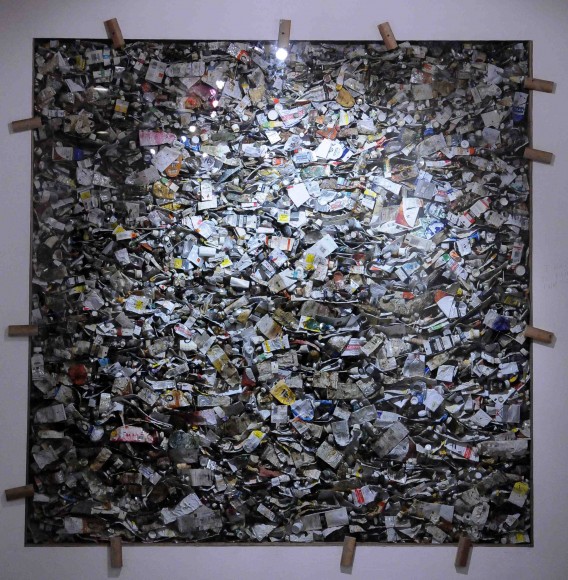
"I have Nothing to Paint and I Am Painting It", 2009, Paint Tubes, Plexi Glass, Image Courtesy of Ma:net Gallery, Photography by M.M. Yu
Personally, I am a convert, to what some may call the traumatisation of art by post modernism’s rhetoric intrinsically linking it to site. The sanctity of the white cube and all the possibilities of various site specificity are here to stay. I like it. Call me a skewed purist or a mis-informed conceptual groupie. It’s true. Which is why Ilarde’s exhibition struck a passionate and recently silent chord within. The reference of the gallery space as a site for reinvestigation, with its perceived closed system of values should be a site in itself for analysis and something Southeast Asian audiences should be encouraged to engage with more. Furthermore, the appreciation and validity of ephemeral art also needs to be considered and discussed. The internal wall surfaces will soon be restored to their original forms, with the work existing only through documentation and the internet. This liberation from the constraints of the object, and thus becoming a non commercial entity/residue (of course documentation can be sold but not at the same prices of ‘original’ works) is something we should be thinking about more. This is the power of the gallery which has not only allowed the ready made to flourish but has become a potent receptacle for pure idea and physical experience.
As O’Doherty mentions, things become art in a space where powerful ideas about art focus on them. (EM)
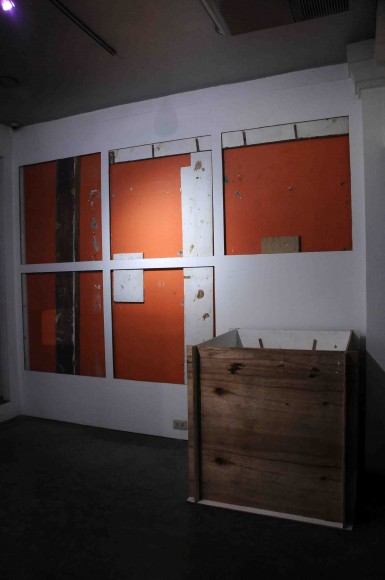
"Specific Abject", 2009, Mixed Media, Variable Dimensions, Image Courtesy of and Photography by M.M. Yu
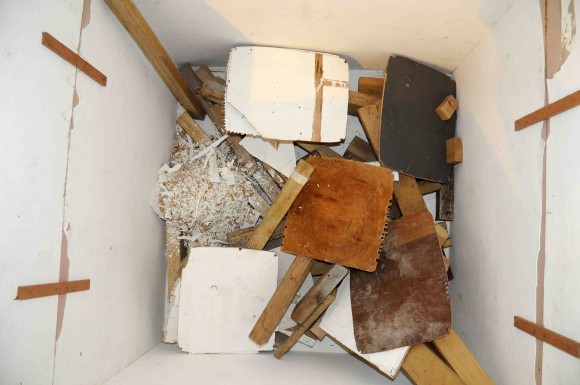
Detail from "Specific Abject", 2009, Mixed Media, Variable Dimensions, Image Courtesy of Mag:net Gallery, Photography by M.M. Yu
1. Mag:net gallery, located on Katipunan Avenue in Quezon City is a meeting point. The café upstairs, with its fusion Japanese food sees its floor currently covered in sand, a beach bar where the Manila art and cultural world converges to talk, debate, laugh and brew its plans for the future. The gallery supports experimental and dynamic creative production in the arts, literature and music and hosts many film screenings, spoken word readings, performances and spontaneous happenings.
2. Appearing as 3 essays in Art Forum magazine in 1976 O’Doherty (who is an artist) was the first to explicitly confront a particular crisis in postwar art as he sought to examine the assumptions on which the modern commercial and museum gallery was based. Concerned with the complex and sophisticated relationship between economics, social context, and aesthetics as represented in the contested space of the art gallery, he raises the question of how artists must construe their work in relation to the gallery space and system.
Sorry, the comment form is closed at this time.
I think I like it. Some thoughts:
– This reminds me of a young New Zealand artist who is another wall surgeon type artist. Well, sometimes he is. Patrick Lundberg makes incisions into the gallery walls for his paintings, but in a gentler, subtler manner. From a 2007 exhibition writeup (from http://www.aut.ac.nz/schools/art_and_design/st_paul_street_gallery/exhibition_2007/px2.htm): “There are intersecting systems in Patrick Lundberg’s wall cuttings: the first is the patterning system, the controlled decorative schema, which is pre-determined and carefully planned for the space; and the second is the system that structures the space and which sits clearly beyond his control – the wall itself, its materials, its skeletal frame, its past interventions, the layers of paint, plaster, glue, dirt, and so on – the effect, in other words, not only of the architect’s and client’s enterprise but also of the activities of the people who have traversed the space over time. There are always moments and places when one structure receives the other (the wall’s receiving of the design) with the least opposition: at other times it becomes resistant. And then there is the scratching through of the layers that produce shifts in shades and depths of colour. These are accidents that end up determining the work’s final form. Lundberg’s “carvings“, despite their impermanence, are grounded in the material fact of the space: the scale of the room, the wall, its materials, his design and of Lundberg himself are all in play during the course of production.”
– I like how the writer of the above blurb sees the wall as being a co-creator of the work (“There are always moments and places when one structure receives the other (the wall’s receiving of the design) with the least opposition: at other times it becomes resistant.”) The wall is a familiar sight/site yet once it is excavated it is unfamiliar territory & the artist never really knows what it hides or when it will comply.
– Can’t find a good image of Lundberg’s wall work but here’s his work with an old kitchen cupboard: http://www.suecrockford.com/common/images/news/LundbergDiptych.jpg
– Looking at ‘Specific Abject’, it’s clever how the sixth square is completed by the solidly three-dimensional cube of the wooden bin (the one that contains the various wall shavings & cuttings from the other works).
– The show seems to add some humour and down-to-earth philosophy to our recession era (art doesn’t exist in a bubble, after all, despite record auction house results!) in that you can make art with what you have! :-D
Oh God! The Cold Cuts show is so embarrassing! The show’s strategy is old hat. These are rehash of 70’s conceptual tautological works wherein the art work refers to itself (or as one of the piece’s title) “it’s own making.” Works are too derivative and as the art reviewer should know his art history – examples abound as in Chris Burden’s excavating the museum in 1983, Lawrence Wiener’s text wallworks, William Anastasi’s scratched wall pieces and wall removals, David Ireland’s wall cuts. But unlike these artists mentioned, Ilarde just cuts them up into bite size pieces. The title “Higher Beings Command: Let There be Lightboxes” is directly taken from Sigmar Polke’s “Higher Being Commands: Paint the Upper Right Corner Black, 1968” or John Cage’s “I have Nothing to Say and I am Saying It, 1950’s.” If this is conceptual art in Manila it has been so behind, like umm, 40 years. This is art for amnesiacs.
“If this is conceptual art in Manila it has been so behind, like umm, 40 years.”
hahaha…u should come to malaysia!!!!
hahaha…
Vincent, you crack me up!
huh? why? wat’s so funny?
i am serious. u should come to malaysia. :)
who’s this anyway? why can’t ppl put in their real names? what’s to hide?
but somehow, i think i know who jbite is…not alot of ppl think i am funny…..
Is art in Malaysia that bad? The problem in Manila is that the artists just look at the international art mags coming from EU and US and try to copy the works they see without really being aware of the context that they were made in. So when a Filipino does a William Anastasi it diminishes the work into quotations. When William Anastasi did the wall removal piece in the 60’s he was questioning the wall as a symbol of the “institution” that supported the war in Vietnam. He was breaking the barrier, wanting to see what’s behind. Actually, he was being “ironic.” But when these Filipino artists use these quotations I think they are not using irony but a form of brown-nosing their masters. Ilarde is trying to tell people that he is sophisticated and that he knows conceptual art and what Polke said, and what John Cage said, etc., etc. And that is what makes the work of Ilarde trivial.
Hi Esmeralda,
If the artist makes his quotations so obvious (to you atleast :P I hardly read these ad laden magazines anymore), couldn’t it be said that way he has removed the contextual issues and replayed them in the Philippines allows us to find the universal points that remains once social and political stories have come and gone and what is left is the cultural legacies to be debated?
Claiming something as ‘derivitive’ is a very unconvincing form of attack in this pomo megamix age. Roman architecture and sculpture was very derivitive of the Ancient Greeks but who makes a big fuss about that? Historians are generally thankful to the Romans for helping to preserve, enriching and spreading Hellenistic culture.
I had a dream this morning of an outdoor exhibition where merely the frames of a gallery were build and pictures floated in mid-air thanks to fishing wires. Must have been the influence of this articles and your sharp critiques.
DC
hi.
Thanx admin very good Article.
What’s Up, just stopping by to show some [holiday|seasonal|Christmas|Kwanza|winter} cheer! I certainly respect how hard it is writing all this information! Have a GREAT NEW YEAR!
Thanks!
Great blog. Keep it up. See you
Thanks for the nice resource
Im reacting to the comments of esmeralda- i know i’m 2 years late but i really want to say a few things about this matter. I’m not really defending nilo, i know this is not one of his best shows but i he has definitely done a lot of important works through the years.
1 well strictly speaking, conceptual art is really 40++ years old anyway. should it age differently here in the philippines?
2 nilo ilarde is not a young artist, he’s been doing this for a long time, maybe close to 30 years already.
3 i don’t expect joseph kosuth to suddenly make text works out of cigarette burns on paper or something. of course he will use his own ‘vocabulary’ and artistic strategies. He will use text, some neon perhaps and refer to some philosophical concept. And i don’t think anyone can fault him for that.
4 i don’t know if esmeralda is actually a filipino pretending to be an outsider, but if he/she is a foreigner then she must try to understand the context and history of filipino conceptual art first before condemning it across the board.
5 i’ve heard comments like “they are just copying what they see in art in america, etc” before and usually it comes from social realists or 70s era abstract expressionist painters. i also hear it from intelligent but not really good artists who ended up as bitter art teachers.
6 actually every aspect of this whole show is a derivative- derived from art history, from the gallery space, from other artists. i think that is the whole point. I think he tried to answer how a show can be made without really creating anything new.
7 conceptual art as a movement is old. conceptual artists are either old, dead or dying. but there are young artists everywhere who are using concept-based strategies in making works that deal with contemporary issues. there are also artists like that in the philippines. and in malaysia as well.
8 its funny how you negate nilo’s use of irony and accuse him of brown nosing just because you think he “Ilarde is trying to tell people that he is sophisticated and that he knows conceptual art” but isn’t that exactly what you did in your comment? you paraded your knowledge of art history concluded that the only people who can appreciate this work are those who don’t know art history the way you do or amnesiacs who have forgotten.